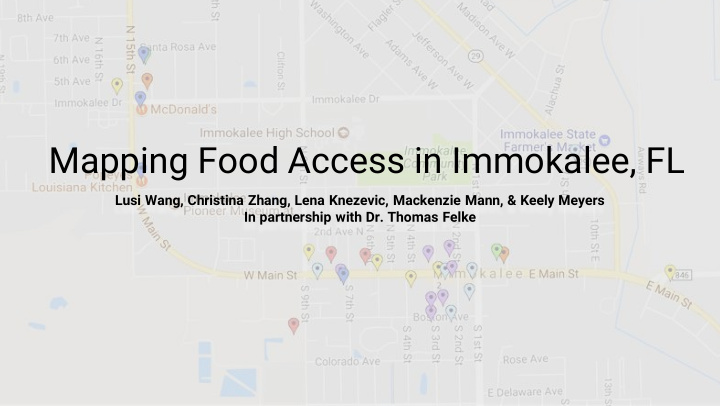



Mapping Food Access in Immokalee, FL Lusi Wang, Christina Zhang, Lena Knezevic, Mackenzie Mann, & Keely Meyers In partnership with Dr. Thomas Felke
Existing food insecurity definition by USDA > ½ mile > 10 mile Food Desert 500 people or/and 33% of census tract population http://americannutritionassociation.org/newsletter/usda-defines-food-deserts
Issues not addressed in this definition Quality (Food Swamps) Transportation Weather
Context: Immokalee, FL - Agricultural community - Census data: - 24,154 residents (underestimate) - 75.6% Latino (Mexican, Cuban, Guatemalan, Haitian) - Over half of residents are foreign born - 44.8% of individuals live below the Federal Poverty Line - 46% of surveyed households use SNAP/EBT
Immokalee, FL - Social issues - Education - Housing ($325/week for trailer section) - Healthcare access - Immigration enforcement - Hurricane Irma - Food insecurity - High prices - Lack of transportation - Availability and quality of foods - Weather
Project Goal Questions: - Where do people in Immokalee buy their food other than supermarkets? - What is sold at these locations? Can SNAP/WIC be used? - What do necessary items cost at these locations? Expected Product: - Create a spatial visualization of food access points in Immokalee, FL, including farmer’s markets, mini-marts, bodegas, restaurants, and other food vendors, as well as data about these access points.
Research Methodology Survey food access points in Immokalee - Access point location - Acceptance of SNAP/WIC EBT cards - Types of foods available - Prices of food items based on size Based on a statewide tobacco vendor survey conducted by the Department of Health in summer 2016 Create a map using ArcGIS to visualize data of how and where residents purchase their food
Food Access in Immokalee N
Findings Figure: 2% milk price for different vendor types - Variable prices - Vast amount of unhealthy food → chronic health conditions - Limited access to healthy fresh vegetables and fruits - Lots of jarred fruit and fruit juices (i.e. Jumex) - Food grown locally is shipped to neighboring communities - Cannot use EBT at farmer’s market - Milk prices and availability - Limited quantities or unavailable - $5-6/gallon - Rotten milk sold at discount - Our collected data can be found here https://drive.google.com/open?id=1bKu8N8yU-uAtAbYb61z3eo72GS_7k8Az]
SNAP/EBT Access - SNAP: Supplemental Nutrition Assistance Program - EBT: Electronic Benefit Transfer card
Reflections - Methodology - Importance of definitions for food purchasing sites - Narrowing the scope of survey questions to better reflect food access - Price differences across brands - Outsiders entering a new community - Unlabeled food and higher prices? - Fear and suspicion - Knowledge of cultural food choices - Language barriers → Spanish/Creole speakers needed - Work with team with diverse backgrounds reflective of the community
Next Steps Mapping data - Population density - Buffer zones (“as the crow flies”) Focus groups with store owners and residents of Immokalee about food purchasing/selling decisions Use models in other communities of southwest FL (Golden Gate, etc.) Hopefully expand EBT access to farmer’s markets and other locations with healthy food options
Recommend
More recommend